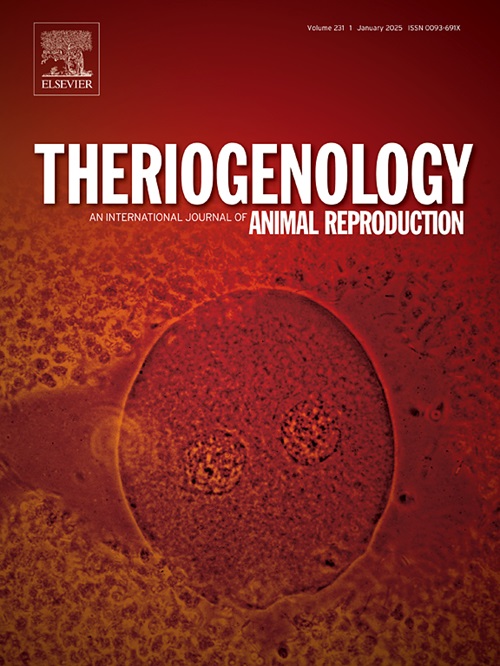Induction of feline fetal fibroblasts into pluripotent stem cells using cat-derived reprogramming factors
IF 2.4
2区 农林科学
Q3 REPRODUCTIVE BIOLOGY
引用次数: 0
Abstract
There are few studies on the establishment of induced pluripotent stem cells (iPSCs) in cats. Although induction using heterologous reprogramming factors delivered via viral vectors has been reported, its safety and reprogramming efficiency still require improvement. In addition, the reprogramming mechanism needs further elucidation. In this study, we constructed a series of expression vectors for cat-derived reprogramming transcription factors based on the piggyBac transposon system and transfected various factor combinations into cat fetal fibroblasts (CFFs) under different electroporation conditions to generate cat iPSCs (ciPSCs). Additionally, the specific roles of these factors in reprogramming were investigated. The results showed that under the optimized electroporation conditions (DMEM/F12 buffer, 300 V, 10 ms pulse duration, 2 pulses, 25 μg plasmid DNA, and 4 mm cuvette), the survival rate and transfection efficiency of CFFs reached 64 % and 67.8 %, respectively. Based on this condition, a seven-factor combination (cOSKM + pNL + SV40 Large T) was confirmed as a better inducer for establishing ciPSCs. The obtained ciPSCs exhibit good pluripotency and passaging stability. They express stemness-related genes and proteins, and can form embryoid bodies (EBs) capable of differentiating into all three germ layers. OCT4 (O), SOX2 (S), KLF4 (K), and c-MYC (M) play important cooperative and synergistic roles in the mesenchymal-to-epithelial transition (MET) during the initial stages of reprogramming, while the supplement of NANOG (N) and LIN28 (L) can further promote MET and is important for successful reprogramming. It lays a foundation for the further breeding of cloned and genetically modified cats, and provides a tool for studying embryonic developmental diseases, screening drugs, and applying to tissue regeneration.
利用猫源性重编程因子诱导猫胎儿成纤维细胞为多能干细胞
在猫体内建立诱导多能干细胞(iPSCs)的研究很少。虽然已有报道利用病毒载体传递的异源重编程因子诱导,但其安全性和重编程效率仍有待提高。此外,重编程机制有待进一步阐明。在本研究中,我们基于piggyBac转座子系统构建了一系列猫源性重编程转录因子表达载体,并在不同的电穿孔条件下将各种因子组合转染到猫胎儿成纤维细胞(cff)中,生成猫iPSCs (ciPSCs)。此外,研究了这些因子在重编程中的具体作用。结果表明,在优化的电穿孔条件(DMEM/F12缓冲液、300 V、10 ms脉冲、2脉冲、25 μg质粒DNA、4 mm比皿)下,cff的存活率和转染效率分别达到64%和67.8%。在此基础上,确定cOSKM + pNL + SV40 Large T 7因子组合是构建ciPSCs的较好诱导剂。所获得的ciPSCs具有良好的多能性和传代稳定性。它们表达与干细胞相关的基因和蛋白质,并能形成能够分化为所有三个胚层的胚状体(EBs)。在重编程初期,OCT4 (O)、SOX2 (S)、KLF4 (K)和c-MYC (M)在间充质-上皮转化(MET)过程中发挥着重要的协同作用,而NANOG (N)和LIN28 (L)的补充可以进一步促进MET,对重编程的成功至关重要。这为克隆和转基因猫的进一步育种奠定了基础,并为研究胚胎发育疾病、筛选药物和应用于组织再生提供了工具。
本文章由计算机程序翻译,如有差异,请以英文原文为准。
求助全文
约1分钟内获得全文
求助全文
来源期刊

Theriogenology
农林科学-生殖生物学
CiteScore
5.50
自引率
14.30%
发文量
387
审稿时长
72 days
期刊介绍:
Theriogenology provides an international forum for researchers, clinicians, and industry professionals in animal reproductive biology. This acclaimed journal publishes articles on a wide range of topics in reproductive and developmental biology, of domestic mammal, avian, and aquatic species as well as wild species which are the object of veterinary care in research or conservation programs.
 求助内容:
求助内容: 应助结果提醒方式:
应助结果提醒方式:


